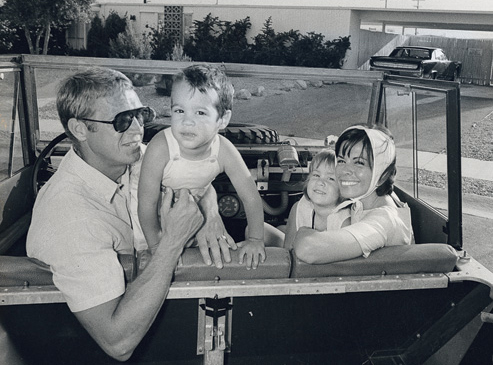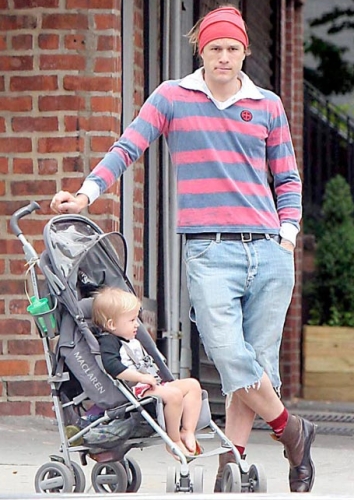 Self-Portrait
Self-Portrait
Timothy Greenfield-Sanders, born in Florida on 1952, is an American documentary filmmaker and portrait photographer, son of Miami musician and teacher Dr. Ruth W. Greenfield. The majority of his work is shot in large format.
Simple yet revealing, his portraits are direct and get right to the heart of the subject. Timothy Greenfield-Sanders prefers to strip away pretentiousness when portraying political figures, entertainers, artists, musicians and other intriguing personalities. His backdrops never distract from the subject, and he often uses a single light source to mimic natural light. His work has elevated him to one of the most acclaimed portrait photographers of our time.
He started out with an interest in filmmaking, and majored in art history at New York’s Columbia University. He later moved to Los Angeles, to study at the American Film Institute. Renowned actors and directors, such as Ingmar Bergman, Orson Welles, and Alfred Hitchcock (“the masters of the cinema”) often made appearances at the school to talk about their work. To document these occasions, AFI sought a volunteer to shoot these visiting celebrities’ portraits. On a whim, Greenfield-Sanders took the challenge and became the school’s photographer.
With these luminaries available to him, Greenfield-Sanders snapped away, and learned much in the process. “Because of AFI, I got tips from celebrities as well as access to them,” he says. Hitchcock once remarked, “Young man, your lights are all wrong,” while Bette Davis criticized him harshly for “shooting from below.” (“She had some great swear words,” he laughs.)
His father-in-law is Joop Sanders, a founder of the abstract expressionist movement in New York, who introduced Greenfield-Sanders to a number of artists. Thus, painters like Willem de Kooning, Larry Rivers and Robert Rauschenberg posed for his camera. Over a 20-year span, he photographed hundreds of artists, dealers, collectors and critics. In 1999, 700 of these images were displayed at the Mary Boone Gallery in New York, and he published an accompanying book, entitled Art World. In the beginning, Greenfield-Sanders’ editorial photos that he shot for clients like Barron’s and SoHo News helped to pay for this project.
Timothy Greenfield-Sanders’ portraits are in the collections of The Museum of Modern Art, The New York Public Library, The Whitney Museum and The National Portrait Gallery among others. In 2004, seven hundred of his art world portraits were accepted into the permanent collections of The Museum of Modern Art and the Museum of Fine Arts, Houston.
A number of books on Greenfield-Sanders’ work have been published: Art World (Fotofolio), Timothy Greenfield-Sanders his first monograph, (Alberico Cetti Serbelloni Editori), XXX: 30 Porn-Star Portraits (Bulfinch Press) “Face to Face” (Skira), Look: Portraits Backstage at Olympus Fashion Week (Powerhouse) The Black List (Atria of Simon and Schuster) The Latino List (Luxury) and The Black List 50 (Luxury).
Greenfield-Sanders produced and directed nine films. His first, Lou Reed: Rock and Roll Heart, was a feature documentary about the legendary rock musician. The film aired in April 1998 on the PBS Series American Masters and premiered in the United States at Sundance Film Festival and in Europe at The Berlin Film Festival. It screened at over 50 film festivals worldwide. Lou Reed: Rock and Roll Heart won a 1999 Grammy Award for best music documentary.
In addition to this once-in-a-lifetime experience, he took the opportunity to build an impressive portfolio of many of the biggest names in Hollywood. His access to these stars bolstered his reputation as a celebrity shooter and he soon got work taking portraits for Interview and People magazines. “I began loving portrait photography more than making films,” he comments. He is also a contributing photographer at Vanity Fair magazine.
Thinking XXX, a film about the making of the XXX book, first aired in October 2004 on HBO. A soundtrack CD was released in November 2004 by Ryko Records. In addition, in October 2004, the XXX portraits were exhibited in New York at the Mary Boone Gallery and subsequently at numerous galleries worldwide including John Berggruen Gallery in San Francisco, Bernd Kluser Gallery in Munich, Berman/Turner Projects in Los Angeles, Paolo Curti Gallery in Milan and Howard Russeck Gallery in Palm Beach.
In 2006, Greenfield-Sanders photographed injured soldiers and marines for HBO’s film, Alive Day Memories. The images were widely published, shown in numerous exhibitions and purchased by The Library of Congress.
Between 2008-2010, Greenfield-Sanders produced and directed The Black List Project: a series of 3 documentaries for HBO, a traveling museum exhibition of portraits organized by the Museum of Fine Arts, Houston, a book with Simon and Schuster’s Atria and DVDs with Target. In addition, the project included an educational initiative in conjunction with The United Negro College Fund.
 Alfred Hitchcock
Alfred Hitchcock
 Orson Welles
Orson Welles
 John Waters
John Waters
 Ethan Hawke
Ethan Hawke
 Toni Morrison
Toni Morrison
 Robert De Niro Sr.
Robert De Niro Sr.
 Elaine De Kooning
Elaine De Kooning
 Louise Bourgeois
Louise Bourgeois
 David Wojnarowicz
David Wojnarowicz
 Francesco Clemente
Francesco Clemente
 Keith Haring
Keith Haring
 Dennis Hopper
Dennis Hopper
 Slash
Slash
 Lou Reed
Lou Reed
 Mark Strand
Mark Strand
 Norman Mailer
Norman Mailer
 William S. Burroughs
William S. Burroughs
 David Bowie
David Bowie
 Scottish indie pop band Travis. Photo by Stefan Ruiz
Scottish indie pop band Travis. Photo by Stefan Ruiz















































































